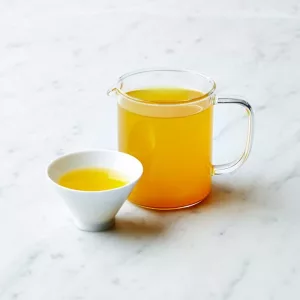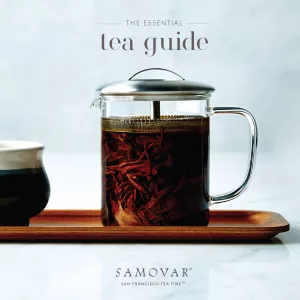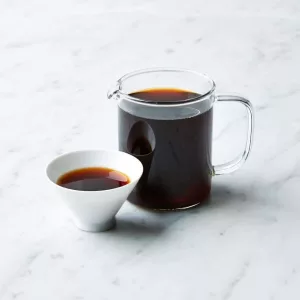Fine Teas Flower in the Bay Area ![]()
By ALLISON HOOVER BARTLETT
Published: June 13, 2004
AROMATIC steam spirals from the thin spout of my tiny teapot. In only a minute or two, I’ll pour the emerald- colored sencha tea into my cup and bring it to my lips. I’ve learned that waiting too long ruins the flavor, and I’ve discovered that when I refill that tiny pot with water, the next cup can taste even better. My education might better be termed immersion: I’ve become a tea zealot – a devotea, if you will – and I’m not alone.
There are more and more like me. Maybe it’s the fog, or a desire to slow down, or just another excuse to partake in one more sensory pleasure. Whatever the reasons, a number of new teahouses have opened in the San Francisco Bay area, the most interesting of which offer a range of Asian or “world tea” experiences.
I’ve been a green tea drinker for more than 10 years, but pathetically limited: I knew what I liked (Gunpowder and Dragon Well), but until recently hadn’t ventured any further. But after one cup of Kukicha Hatsukura Supreme at the Samovar Tea Lounge, in San Francisco’s Castro District, I decided to set out on my own tasting trek. It has taken me from one sumptuous teahouse to another, all of which offered food – from light snacks to full meals – yet also welcomed those simply interested in a cup of tea.
 My first stop was the Samovar, where more than a hundred varieties of Asian, colonial, Eastern European and Middle Eastern teas are offered ($3 to $11 per serving). The food ranges from small snacks ($1.75 to $4.95) to a Russian high tea service from a samovar ($11 including such treats as tea toasts with caviar) to entire meals (tea, appetizer, main dish and dessert are around $20 a person).
My first stop was the Samovar, where more than a hundred varieties of Asian, colonial, Eastern European and Middle Eastern teas are offered ($3 to $11 per serving). The food ranges from small snacks ($1.75 to $4.95) to a Russian high tea service from a samovar ($11 including such treats as tea toasts with caviar) to entire meals (tea, appetizer, main dish and dessert are around $20 a person).
Samovar’s pan-Asian interior is elegant and cozy, and with the sun streaming through the windows and world music playing softly, people tend to linger. At one end of the restaurant is a raised platform with a long table, where people sit on straw pillows under the gaze of a large 400-year-old statue of Bodhisattva Kuan Yin, who looks especially relaxed, one arm resting on her bent knee. The crowd is varied, from young couples, to writers at their laptops, to grandmothers sipping with their grandchildren.
While I was there, a number of young women were taking part in another ageless but now popular pastime: knitting. And if the eclectic crowd doesn’t provide enough entertainment, the magazine rack in the corner offers such off-beat choices as Giant Robot, Surfer’s Journal and DestinAsia.
My husband, John, came with me, and both of us thought we’d try oolongs, which lie somewhere between the greens and the blacks on the tea oxidation scale. One of the most significant distinctions between varieties of teas is the degree to which they are oxidized – that is, exposed to air while drying. The process is often assumed, incorrectly, to be fermentation, which usually implies additives.
In choosing our oolongs, we were swayed by nomenclature and the elaborate descriptions: I went for the Monkey Picked Iron Goddess of Mercy (“Kuan Yin’s classic elixir offering transcendence via the tealeaf”), a smooth, full-bodied, slightly floral tea that is $6 for a small pot. And John chose, predictably, Caressing Royal Concubine (“Sip by sip, all-consuming rapture”) for $7. It tastes the way tropical flowers smell: like honey.
Later I learned the reason for this tea’s potent flavor; farmers take caterpillars to the tea bushes and let them devour the leaves, which causes the plants to put all their rejuvenating energy into the next season’s harvest: these are the robust leaves used for
Caressing Royal Concubine.
I ate Asian – the bento box with ginger baked mahi mahi ($8.95), and John decided on a grilled sandwich (Gouda and cured ham on rye, $6.50). While the menu features some English and Russian fare, the best of it – and most of it – is Asian. For dessert, we ordered two delicate white teas, which our tea server described as “tea at its purest.’’ Apparently, because of its very slow, controlled drying process, only this type of tea retains its leaf- bud color. Our Snow Buds ($5) and Wild Rose Silver Needle ($5.50), were lovely, but were overpowered by our decadent chocolate dessert choices. Oh, the art of matching
tea to food. We should have asked for recommendations.
While tea’s health benefits may be one reason places like Samovar are so popular these days, good taste is certainly another. A cup of Starbucks was enough to induce many to swear off Folgers – and there are plenty of inducements to move beyond Lipton. In addition to oolongs, greens, whites and blacks, there is the Pu Erh variety from Yunan Province in China, a dark, almost espresso-like tea that’s surprisingly low in caffeine.
Pu Erhs, I learned, are also the only aged teas – that is, they are oxidized much longer than other teas. Some of the oldest are aged for more than 100 years. Like wine, Pu Erhs are stored in a manner (sometimes buried or put in caves) that enhances taste. And like fine wines, these teas are more prized the older they get, and more expensive. I tried a pot of Jingmai Mountain at a later visit to Samovar and concluded that with its intense flavor, it would have been a better choice with our chocolate desserts.
I also noticed that the service at Samovar can be slow, which turned out to be the case at every teahouse I visited. Yet rushing would be beside the point. We were there to savor, as were the throngs of customers lined up to order at the counter.
Our next stop took us to the edge of the Bay where Alice Waters was among the customers at the new Imperial Tea Court in San Francisco’s beautifully refurbished Ferry Building Marketplace. For years, the Imperial Tea Court has been regarded as the quintessential teahouse in Chinatown, and this new branch, set in the city’s bustling cathedral to cuisine (the Marketplace houses local purveyors of every imaginable gourmet food), is a refuge for weary shoppers.
Open on one side to the Marketplace, and hung with red lanterns and delicate bird cages, the Imperial Tea Court has the feel of an exotic, intimate, sanctuary; it seats about 25. We brought our kids, aged 10 and 13, who drank water instead of tea but thoroughly enjoyed the experience.
We ordered the gong fu tea service ($8 a person), which is something like a Japanese tea ceremony, but less refined. Our waiter, a gracious young man in a silk jacket, arrived with a number of unglazed teapots of various sizes and explained (to our rapt children) that they were made from river-bottom soil. He ceremoniously bathed the cups and pots by pouring steaming water over them, which ran into the hollow tin tray beneath. He recommended the Old Bush tea, and although the political jokes brewed faster than the tea, we tried to stifle them.
Our waiter passed us a small vessel with the dry leaves, which smelled remarkably like cocoa. Then, after wetting them, he passed it again. The aroma had been transformed into something leafier, more subtle. He swept the wetted pot in a circle around the tray – to wipe off the drips, he explained, and to move the leaves to the center of the pot. Then he poured one of the most flavorful teas I’ve ever tasted.
The staff at these teahouses is generally eager to impart knowledge, and I learned a fair amount while sipping (or slurping, as this waiter recom- mended). All kinds of tea, for example, come from one plant, the camellia sinensis. Differences in the soil, climate and topography of the growing regions, and in methods of harvesting and processing distinguish a Green Peony Rosette from a Lapsang souchong. And herbal teas are not techni- cally tea, but rather infusions of herbs.
With the Old Bush, we ordered both the dim sum sampler ($6.50) and the snack sampler ($4). The dim sum included savory vegetarian steamed buns filled with chopped baby bok choy and shiitake mushrooms; subtly seasoned shrimp dumplings in glassy wraps; and delicately fried spring rolls, with shredded cabbage, carrot and coconut. The light snacks includ- ed ginger roasted almonds, fl aky, short peanut cookies and lovely, green tea-dusted pumpkin seeds. Items can also be ordered individually ($2).
Tibetans call tea “the water of long life.” Based on the number of people hoping to get a table at the Imperial Tea Court, it appears many are bet- ting on it. A steady stream of customers strolled into the restaurant with cherry blossom branches wrapped in newspapers and red mesh sacks of oranges from the Farmers Market outside.
Elegant teapots, cups and tea paraphernalia, including many beautiful gong fu services, are for sale.
Our last stop was Celadon Fine Teas, across the bay in Albany, a town next to Berkeley. It was an unseasonably warm spring day, and when we walked through the open doors, we stopped and slowly swiveled around to take it all in. A trip here is as much about architecture as it is about tea. Designed by Fu-Tung Cheng, a Bay Area kitchen designer, Celadon radi-
ates with subtle colors and handsome materials: grays, greens and browns shimmer through a balance of glass, wood, tile and metal.
On this quiet Sunday afternoon, most of the tables were full, so we sat at the bar, an arc of olive-colored concrete, flecked with turquoise stone and inlaid with fossils. Our waiter brought us menus and, after much ogling at our surroundings, we perused them. While Celadon sells about 70 types of tea, the tasting menu features only about a dozen. They are listed according to variety and caffeine potency, and since John and I were both in need of a boost, we skipped over the whites and greens. I ordered a pot of Lichee Red ($4.75), a “Cantonese favorite,” according to the menu. Poured into a yellow porcelain cup lined in white, it was a beautiful shade of cedar and tasted faintly floral and quite sweet.
I asked the waiter what gave the Lichee Red its color, but as with other questions I asked here, I wasn’t given much of an answer (“something to do with its processing”). While the waiters were courteous and friendly, they didn’t seem as knowledgeable about tea as servers at other teahouses.
John ordered a pot of Taiwan Beauty ($5), a honey-colored tea described as “floral, robust and spicy,” but I found it more grassy, almost vegetal, with a little bite. Both our teas were exceptionally smooth, even after numerous infusions of fresh, steaming water.
There are a few selections of pastries at Celadon, ($2 to $4 each) varying from day to day. We ordered the pear ginger tart, a thin, rich wedge that was superb, and a couple of disappointingly bland mochi, Japanese rice pastries.
Between sips of tea, there was much to appreciate: the narrow river of wa- ter trickling down the center of one of the counters, the tea strainers made of small gourds with green silk tassels, the mushroom-shaped rice paper light fixtures, the antique tea tools-and many delicate tea services for sale.
Throughout my tea-tasting journey, I found alluring havens to sample tea. The only thing I didn’t fi nd was someone who could read my fortune in a cup. Once, I noticed leftover leaves that looked something like a kangaroo. At home, when I consulted a couple of Internet sources on tea leaf-reading, I learned that I can look forward to either travel to exotic places or harmo-
ny at home. I chose to believe both.
TEAHOUSE INFORMATION
Samovar Tea Lounge, 498 Sanchez Street, San Francisco; (415) 626-4700;
online at www.samovartea.com.
Open every day, 9 a.m. to 10 p.m.
Imperial Tea Court, 1 Ferry Building Plaza, San Francisco; (415) 544-9830;
www.imperialtea.com. Open Tuesday through Friday, from 10 a.m. to 6 p.m.;
Saturday 8 a.m. to 6 p.m.; Sunday 11 a.m. to 5 p.m. Closed Monday.
Celadon Fine Teas, 1111 Solano Avenue, Albany, Calif.; (510) 524-1696; on the Web
at www.celadontea.com. Open Tuesday through Thursday, and Sunday, 11:30 a.m.
to 7 p.m.; Friday and Saturday, 11:30 a.m. to 10 p.m. Closed Monday.
ALLISON HOOVER BARTLETT is a writer who lives in San Francisco
July 13, 2004
“…Samovar’s pan-Asian interior is elegant and cozy, and with the sun streaming through the windows and world music playing softly, people tend to linger…”
Lovely pots, cups, teas and related accouterments are for sale here.
July 13, 2004
Photography by Caren Alpert for the New York Times
Media Contact:
Jesse Cutler, Samovar: (415) 655-3431 / publicity@jpcutlermedia.com





